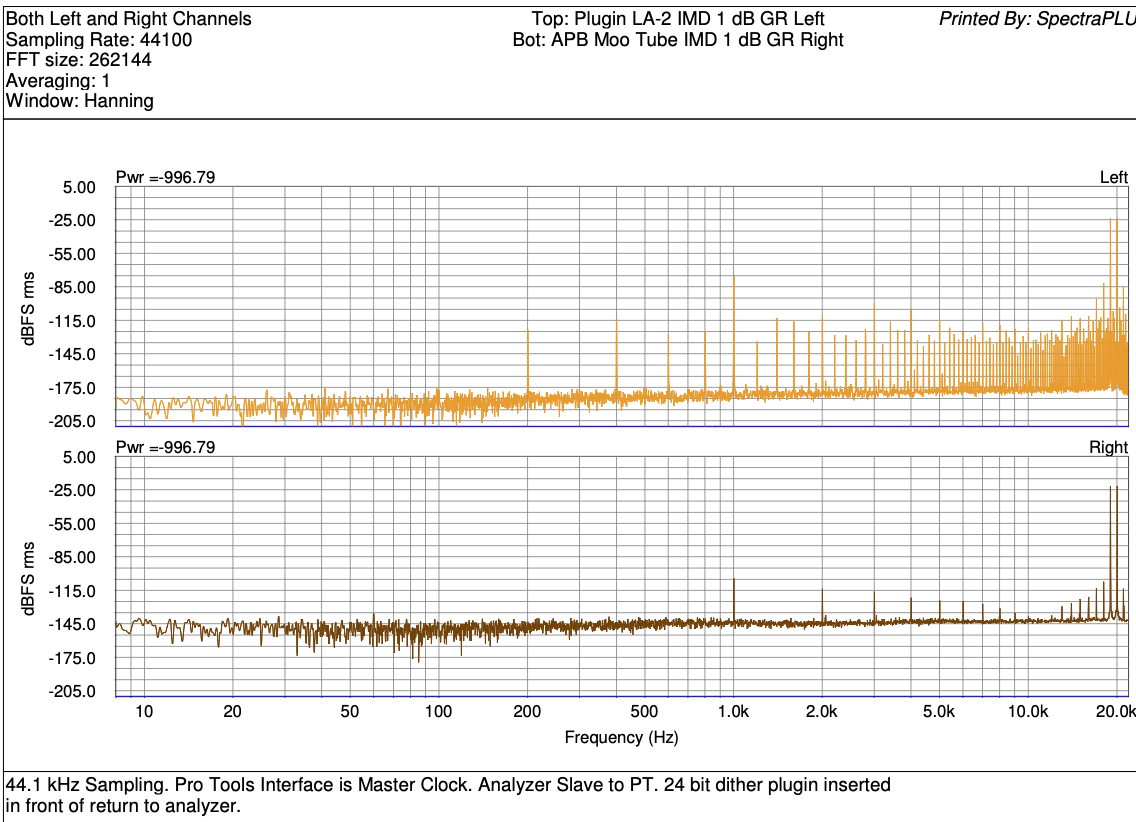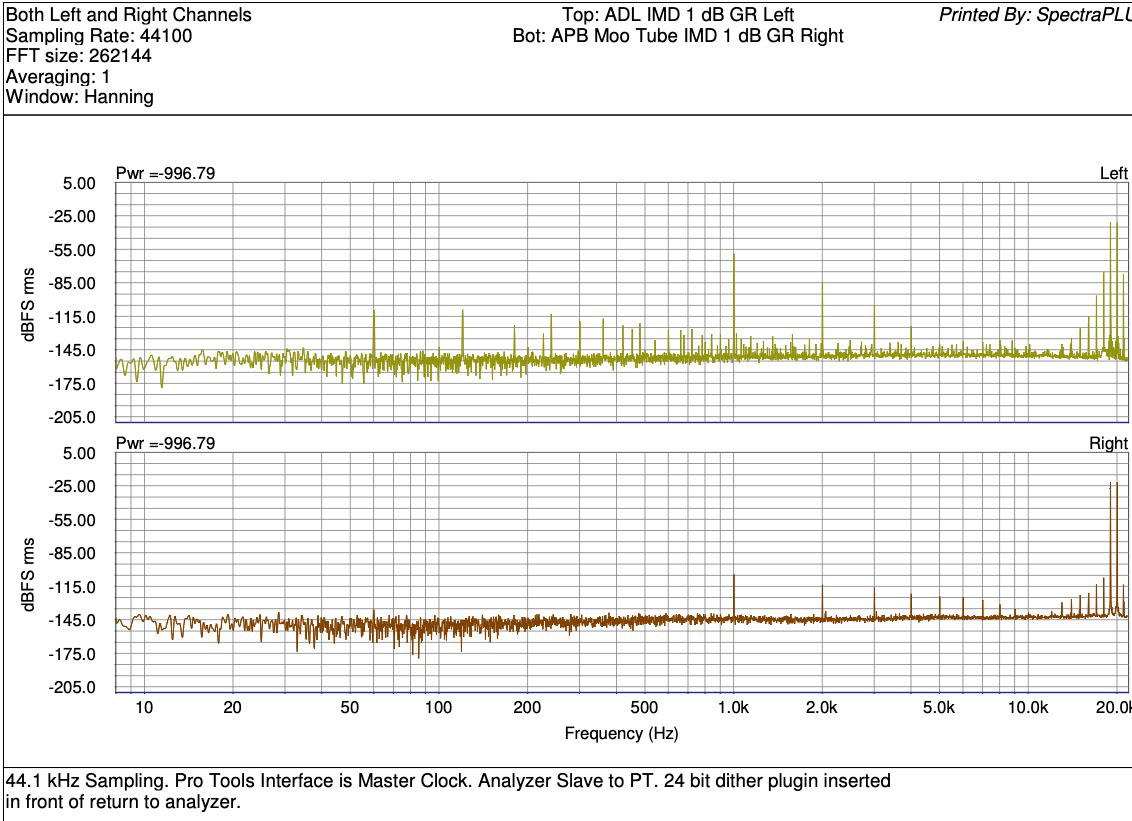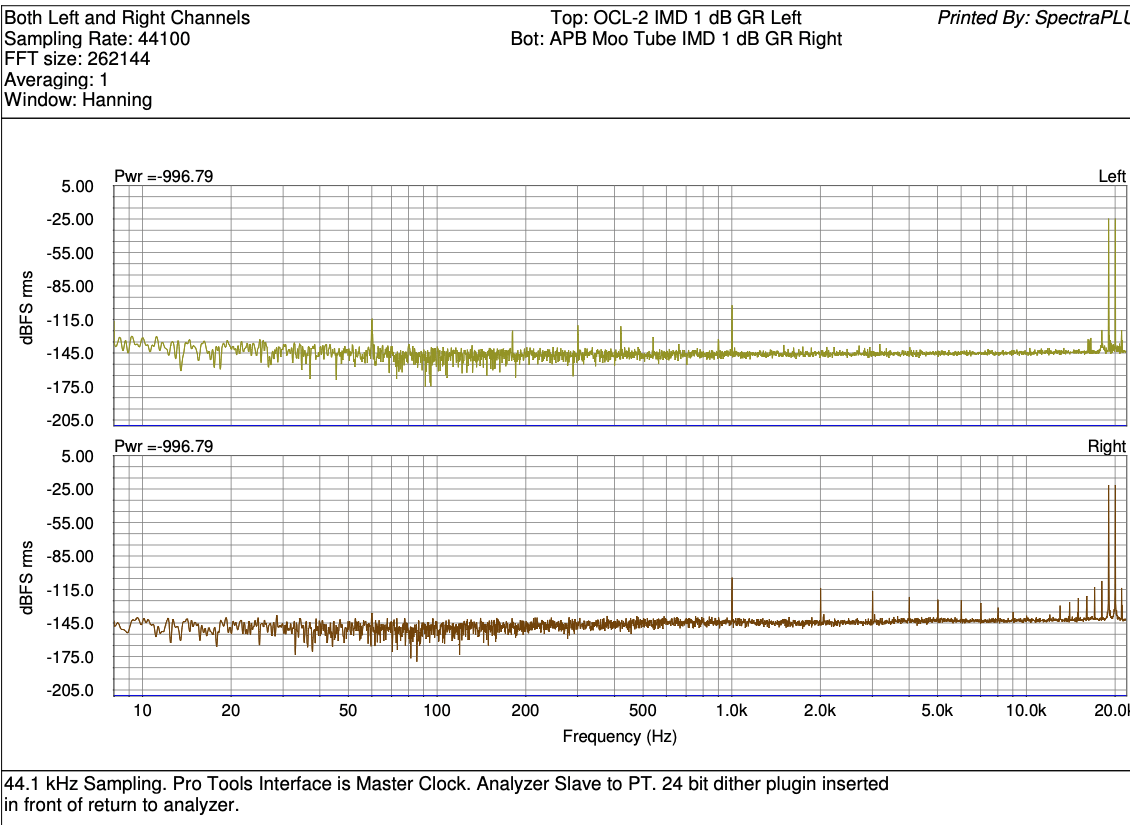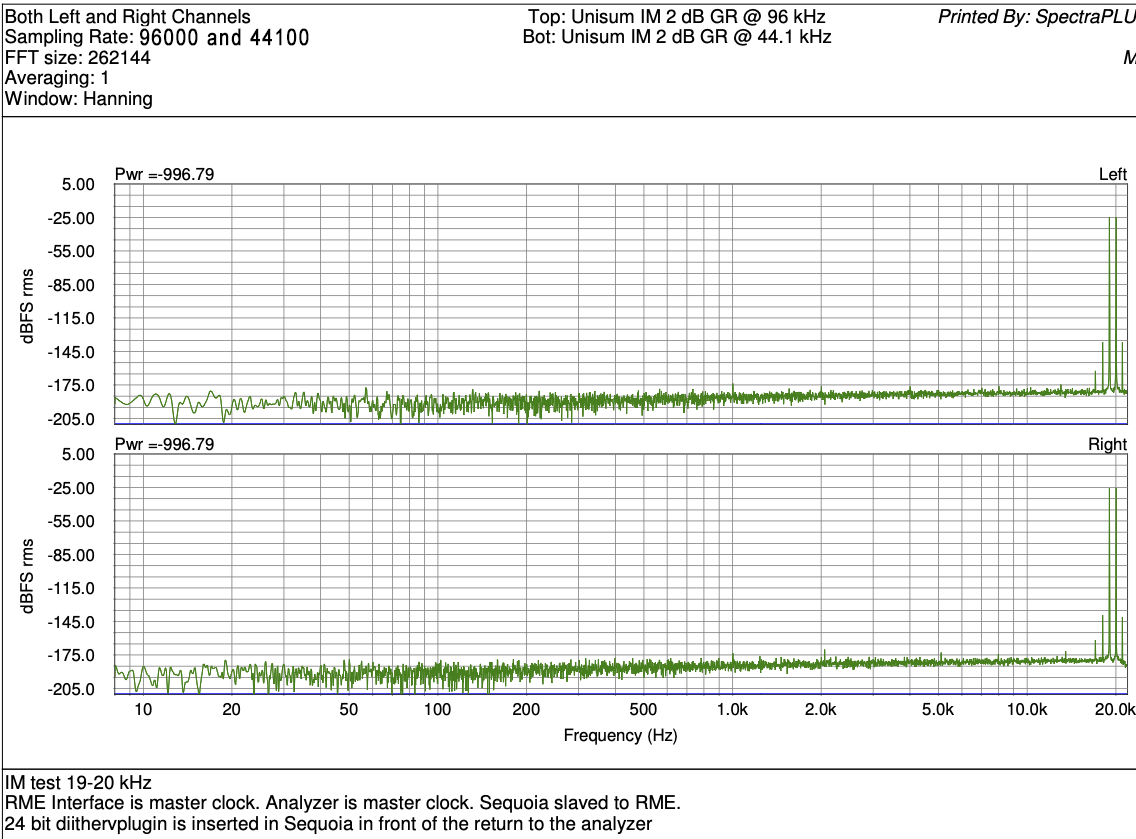Bob Katz
President and Mastering Engineer: Digital Domain
November, 2022
The day before Thanksgiving I wrote a blog found here offering my views on the sound quality of some compressors and providing a theoretical basis for the superior sound of the analog models. I introduced a unique processor, the McDSP APB-16, which eliminates the aliasing issue entirely by incorporating a DAC and an ADC with digitally-controlled analog processing in between. In fact, the APB is a true analog processor. The plugin part is just a controller. Today I’m going to dig deeper and try to correlate the measured performance of different compressors with their subjective sonic attributes.
As I mentioned, the higher the sample rate, the lower the aliasing distortion in an all-digital compressor. Today I’ll show you the worst case scenario, asking our compressors to run at 44.1 kHz sampling rate: For testing, I send a 19 and 20 kHz intermodulation test signal digitally into Pro Tools from my analyzer, SpectraPlus. Within Pro Tools I am able to insert analog outboard gear or plugins and then return the signal for analysis. Since AES/EBU is limited to 24 bits, I insert a 24-bit dithering plugin just before the return feed to the analyzer.
Clipping, saturation, emulation and distortion performed in the digital domain are not easy things to get right. You get the distortion that you want mixed with distortion that you do not want.
In Figure 1, at the top is the spectrum produced by an all-digital plugin that emulates the characteristics of a UREI LA-2A, a classic analog tube and opto-based compressor. The 19+20 kHz test signal is at about -20 dBFS RMS and the compressor adjusted to produce about 1 dB of gain reduction. As you can see, this digital plugin produces a tremendous amount of digital “grunge”, caused by aliasing: intermodulation between the harmonics of the high frequency test signal and the Nyquist frequency. You can see evidence of the aliasing at 200, 400, 600 and 800 Hz and in the dense spectrum above 1 kHz. I think this makes a fuzzy sound quality, adding a slight veil and harshness to the sound, whereas a real LA-2A is warm but relatively transparent, as is the APB Moo Tube to my ears. Keep in mind that emulation and other non-linear processes perform much better at higher sample rates, but it takes a very high sample rate to completely eliminate aliasing distortion.
In addition to the aliasing, we also see evidence of IM distortion, interaction between the 19+20 kHz components and their harmonics. For example, the 1 kHz difference product and the extra spectral lines near the test signal. IM can occur in any all-analog amplifier, especially classic tube processors which often exhibit a lot of IM, and this can be seen in the spectrum of the LA-2A emulator. Is IM desirable? Is it part of the fuzz, or just part of the sound of the original LA-2A? Well, anyway, if you want to make an authentic LA-2A emulation, you’re going to have to produce some IM distortion. IM is definitely more “natural” than aliasing. IM is an interaction between the existing audio elements, while aliasing is an interaction between the audio elements and the sample rate, the latter yielding lots of inharmonic products that have no relationship to the musical notes. It could be said that IM is much less egregious in character than aliasing, but too much IM, which sounds harsh, is an impediment to transparency and warmth.
The 1 kHz IM product is common to both processors, but at a much lower level in the APB Moo Tube (bottom display in Figure 1): about -105 dBFS, 30 dB lower than in the digital LA-2A emulation. Clearly, APB designer Colin McDowell does not consider IM to be that desirable. The cluster of small products near the test signal are produced by slight non-linearities in the APB’s digitally-controlled analog processors, but they are at a very low level and at very high frequency so likely to be inaudible or at least inconsequential.
Harmonic distortion is another type of distortion, evidence of which can be seen in the harmonics of 1 kHz visible at 2 kHz, 3 kHz, etc., which are severely masked by aliasing in the all-digital product, but clearly unmasked in the APB, where the 2nd and 3rd harmonics contribute to its perceived warmth.
The Cleanest Tube Compressor
Not every tube processor is “extra warm”. Let’s compare the Moo Tube to the cleanest tube analog compressor in my rack: the Pendulum OCL-2, a modern design tube opto compressor. In Figure 3: We use a 19-20 kHz test signal. On top is the output of the OCL-2, and at bottom, again the APB Moo Tube. As you can see, the OCL-2 is very clean, with just some low level power supply products below 1 kHz, a very low 1 kHz difference product at -105 dBFS, and barely-visible difference products near the test signal. I see no obvious evidence of harmonic distortion in the OCL as the 1 kHz IM product is too low to excite the tubes in the OCL-2. But the OCL-2 does produce some low harmonic distortion with a high enough test signal (not shown). Still, the OCL-2 is not very “tubey” sounding and if I’m looking for color and warmth I look elsewhere. The Moo Tube measures almost as clean, with an identical level 1 kHz difference product, some harmonics of that product, and additional very subtle evidence of intermodulation near the test signal. Since the OCL-2’s 1 kHz difference product is at identical level to the Moo Tube’s, I suspect the reason we see more HF distortion near the test signal in the Moo Tube is that the Moo Tube has much greater bandwidth.
If you drive the output of the Moo Tube harder it will saturate and produce additional harmonic products so it can be used for color (not shown). But it is not a harsh color because it does not alias —it’s a true analog processor, even though it is accessed through a plugin.
Unisum and Kelvin: Oversampling Digital Compressor and Distortion Generator
I’ve known about Tone Projects Unisum Digital Compressor for a few years, and tried it out quickly a while ago... I found it very powerful and clean, a real rival to my analog compressors! But since I have the best of analog at my disposal, I set the Unisum aside — until now.
Unisum has a “pristine” mode, with impeccable oversampling, as revealed by my IM measurements in Figure 4, Unisum with 2 dB of gain reduction. On top, at 96 kHz. At bottom, 44.1 kHz. No, this is not a measurement mistake! There is no difference in distortion at either sample rate! There is no trace of aliasing, just a little bit of high frequency IM distortion at a very low level near the test signal. Just like analog processors, Unisum doesn’t care what sample rate you run.
This is an impeccable result — blows my mind! Unisum is a bit daunting to operate, with controls that you don’t normally see in compressors, including release character that’s continuously variable between log and linear. I barely have time to explore and learn about all these options. But there are many presets from users which you can always load until you find what you like, from gentle, including opto character, to aggressive.
Want to see another tool that blows my mind? Another plugin from Tone Projects called “Kelvin”. Kelvin is an extremely versatile harmonic distortion generator. You can set it to produce pure 2nd harmonic, and/or pure 3rd, in series or in parallel and each harmonic fully adjustable in level. And just as exciting, 19+20 kHz IM tests (not shown) reveal that in “Pristine” mode, Kelvin does not alias at any sample rate! For years one of my dreams has been to have a plugin with harmonic control in a plugin — finally someone has implemented a “clean” distortion generator. Kelvin has presets to produce musical or grungy harmonics emulating classic transformers and other classic circuits from tubes to transformers, to solid state. Here (Figure 5) is a comparison of Kelvin’s “Purple” preset with the “Dark Iron” preset. Purple is largely a combination of 2nd and 3rd harmonics, while Dark Iron adds some 4th through 7th. I’ve only touched on what you can do with Kelvin: my review just scratches the surface of this powerful plugin. Pop mix engineers will go gaga with Kelvin, adding “clean” analog character to instruments and vocals.
Unisum has a “Hygge” button, which adds a fixed amount and type of harmonic distortion, but I would leaving Hygge off and put Kelvin in series with Unisum, as Kelvin is infinitely tunable as well as tuneful!
Other Ways Around the Aliasing Issue
Two other plugin approaches can significantly mitigate high frequency aliasing: Multiband and Parallel. With the multiband approach, restricting the high frequencies to a single band will mitigate aliases from entering the lower bands. With parallel compression, if you mix the “wet” in with the dry, the attenuation of the wet section also attenuates the amount of its distortion in the mix. A plugin from Leapwing, the Dyn One, sounds very nice and pure to me, as it combines both of these advantages: parallel compression and impeccable multiband! I use the Dyn One quite frequently in mastering for invisible lifting. I’ve contributed presets to the Dyn One, by the way. Another plugin is a multiband parallel comp: The TC Electronic Native MD-4, to which I have also contributed presets. I think you need both of these plugins, as the dynamic response of the Leapwing and the TC are different, with different philosophies of attack/release characteristics. A 3-band that I often use on stems sounds very sweet on mild acoustic instruments: The PSP Old Timer MB. However, I haven’t tried the OldTimer MB on aggressive or bright material like loud trumpets. If you try it, let us know how it does in a demanding situation.
Character?
Then there is the question of character and capability. For example, can an all-digital API-2500 emulator plugin provide the grit, drive and punch of a real API-2500? At extreme amounts of gain reduction? I’ve certainly found the APB-16’s “Chickenhead” plugin compressor as punchy and powerful as an outboard API-2500. Chickenhead doesn’t pretend to be an API clone, but it is capable of being just as aggressive, fat and punchy as an API. And no aliases! What about Unisum? Can this all-digital comp punch as well as a real API? At this point I haven’t yet explored Unisum thoroughly, but it’s very promising. I urge you to try it and let me know what you think. Unisum may be the first single-band digital compressor that can punch as well as an analog box and sound transparent — without introducing aliasing fuzz or other artifacts.
What We Don’t Know (yet)
Keep in mind that we have very little science to quantify the sonic impact of these measurements, although I’ve certainly tried to interpret them to the best of my ability. These measurements, made at 44.1 kHz sample rate, are the worst case scenario for non-upsampling digital processors. The ones that do not upsample do perform better at higher rates, while the analog models and the APB remain free from aliasing at any sample rate.
Although Unisum’s upsampling measures impeccably, it’s up to us to listen and compare, see if it sounds truly as transparent as an analog box. Let us know what you think. Frankly, I’m spoiled rotten by all my analog tools, plus the APB, plus the Dyn One (in parallel mode), so I haven’t had time yet to use Unisum in a session and compare.
Regardless, these new and amazing digital developments look very promising. We’ve waited a long time for plugins that may sound as good as analog. The next step is a shootout: The best of analog versus the best of digital. This story is not over yet!
Share this Article






